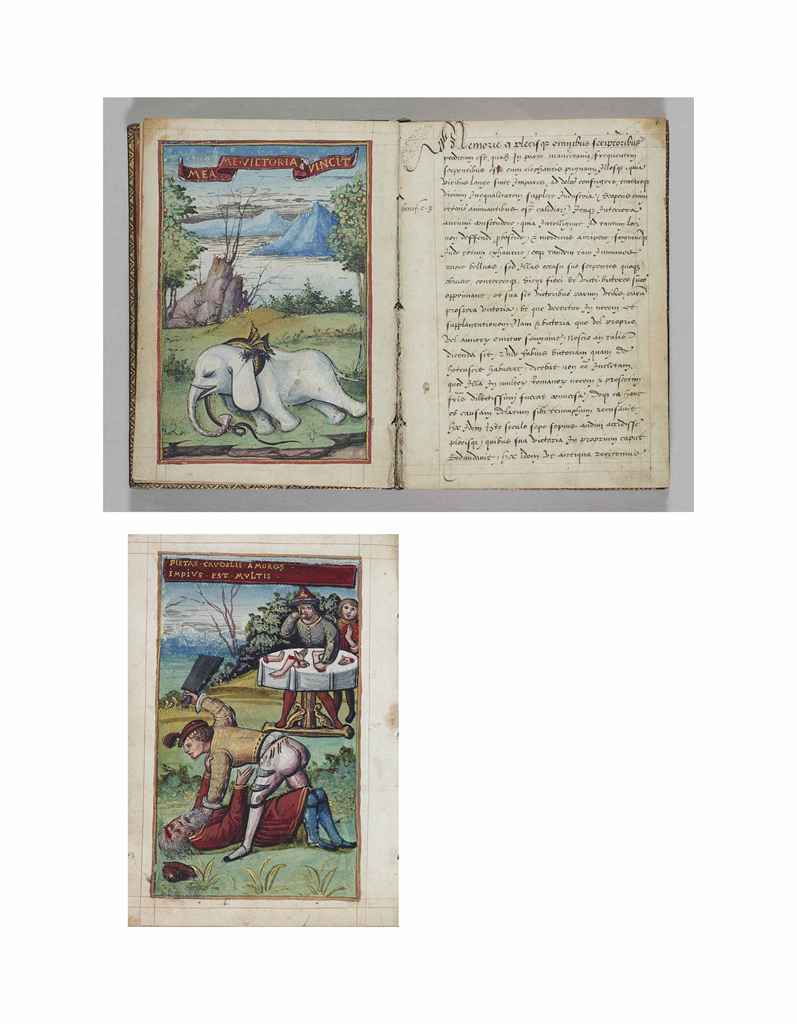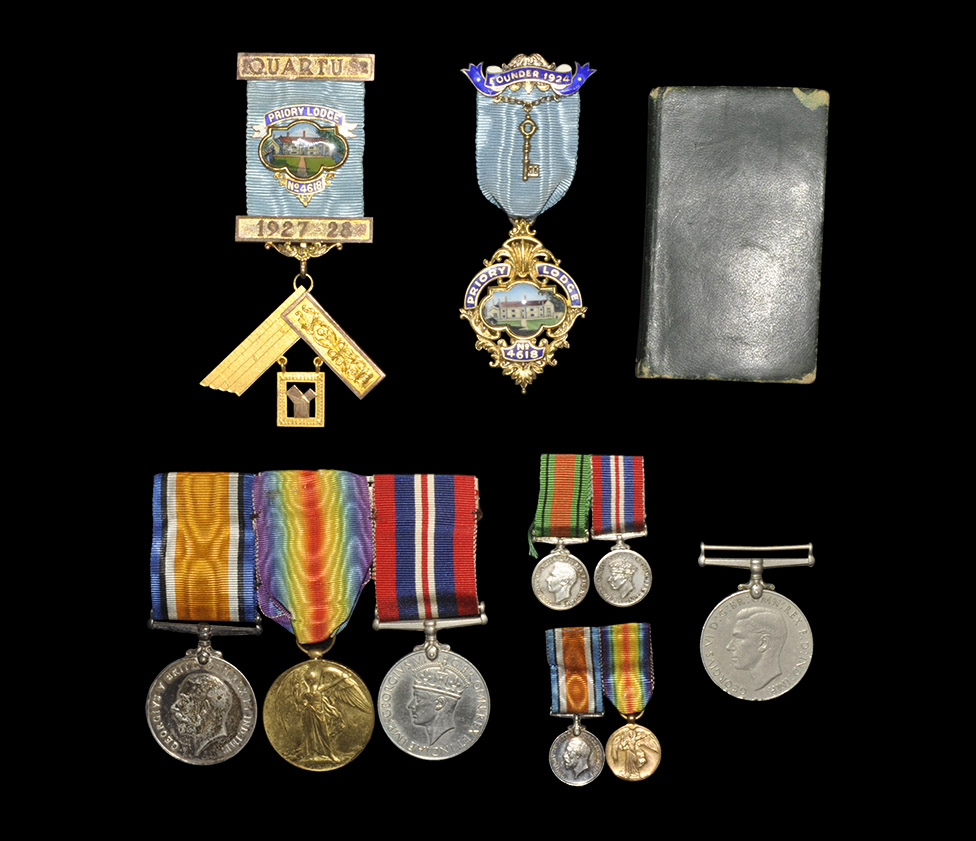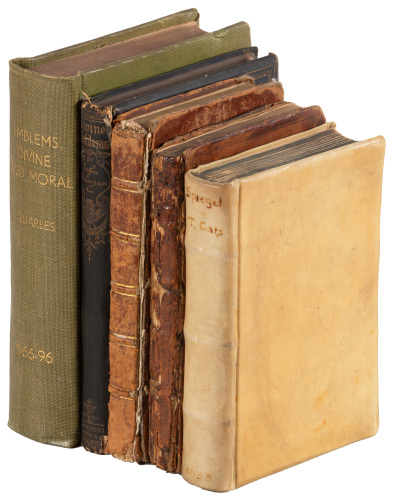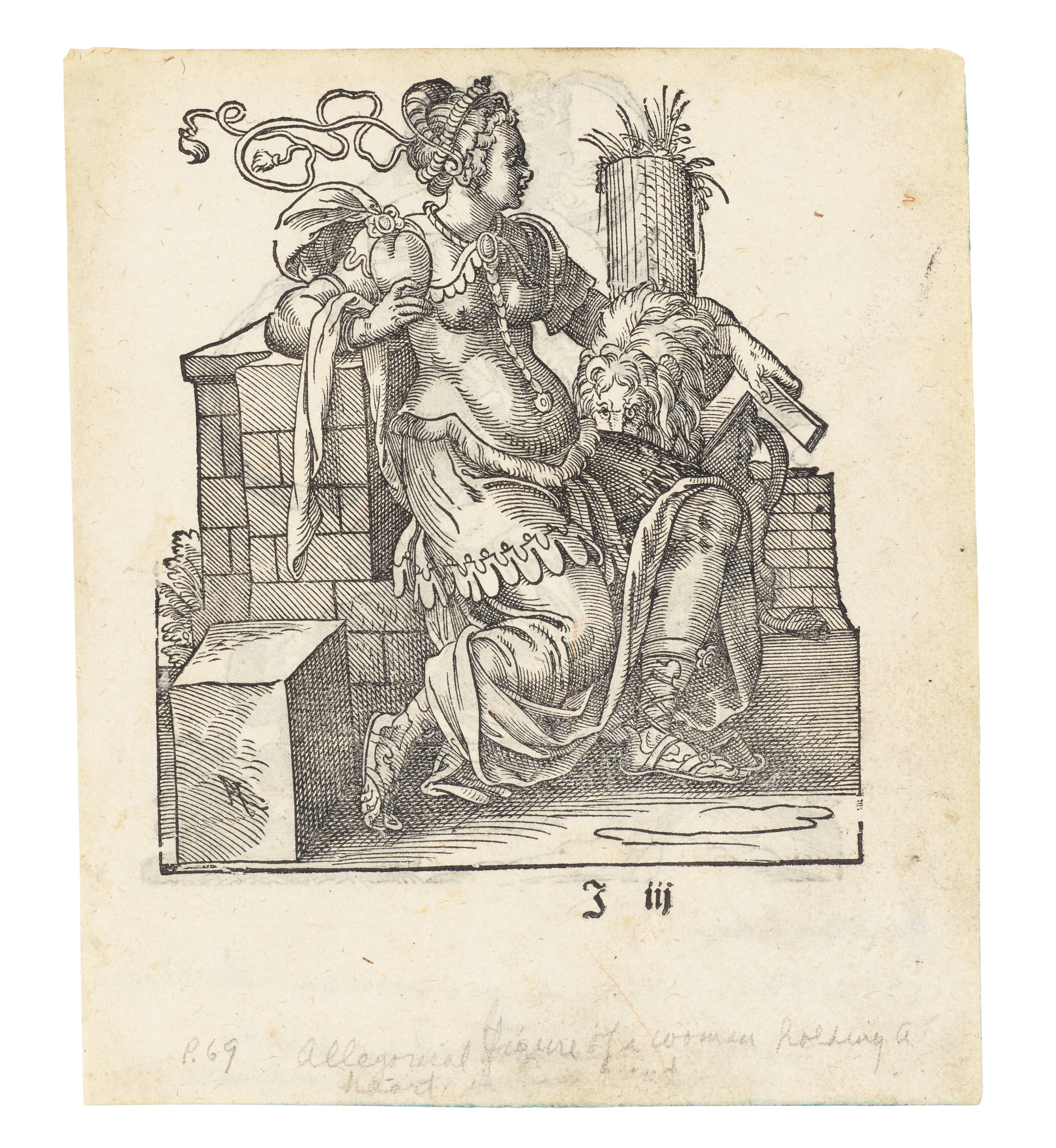EMBLEM BOOK, with loose mottoes in Latin and Italian with Danish translations, ILLUMINATED MANUSCRIPT ON PAPER [?Denmark, late 17th century]181 x 140mm. 86 leaves of paper with a watermark of a crowned lion in a circle containing letters, COMPLETE, with 45 loose slips with mottoes written in two perhaps contemporary hands with Danish translations in a nineteenth-century hand, one motto written onto last leaf with translation, FORTY-THREE EMBLEMS PAINTED IN FULL COLOURS WITH GOLD (some staining, wormholes in margins). Contemporary ?Danish mottled sheep gilt, central foliate tools, gilt foreborders, foliate cornerpieces, spine gilt in compartments, gilt edges (scuffed and wormed, head of spine and corner of lower board chipped, lacking ties). PROVENANCE: Lieutenant Bonfils: loose letter to him dated Copenhagen 1830 inside upper cover; his ownership inscription on first leaf dated St Canute's day (7 January) 1828; the Danish sculptress Adda Andrea Elisabeth Bonfils (1883-1943), inscription on first leaf dated 26 May 1920. CONTENT: An emblem is painted on every alternate verso and it seems likely that the original intention was to write the explanations of the emblems, mottoes and perhaps verses, on the facing rectos. The intervening versos were probably left blank so that the emblems would not be obscured by writing coming through from the rectos. The emblems may have been garnered from one or more of the numerous collections in print. About fourteen of them, for instance, relate to Daniel de la Feuille's Dévises et emblems anciennes et modernes , published in 1691. At an uncertain date, some of the emblems were numbered in ink at the lower right and mottoes were written onto loose slips of paper, perhaps soon after the completion of the paintings. The mottoes were translated into Danish in the nineteenth century. In the nineteenth or twentieth century, the remaining emblems were numbered in pencil and pencil numbers were added to all but six of the mottoes; two were given very hesitant numbers. It is not clear that these pairings of emblems and mottoes are the ones originally intended, or even that these mottoes were the ones the artist had in mind. The mottoes are seldom those popular in the emblem books, where some appear associated with other emblems. They suggest a certain amount of personal inventiveness. The decision to put the mottoes on loose slips, instead of on the facing rectos, may have been motivated by the desire to leave the possible meanings open and even to treat the collection as a kind of game, where people could be invited to match mottoes and emblems. Is it even possible that the two slips with Non intelligo could have been a variety of wild card or joker? The unusual format offers intriguing insights into the appeal of emblem books and the way they could be used. The emblems are delicately painted with great refinement of detail - the tiny insect in the candle flame, no 20, could easily be overlooked. Flames, suns, highlights and trimmings are all depicted in gold, which enhances the delicate colours. Settings are minimal, in the manner of many printed emblem books, but have a distinct character in their avoidance of the human figure, restricted to arms emerging from clouds and to the heads of wind gods. The sun is always given an endearingly smiling face, as in the de la Feuille collection among others. The emblems are as follows; a bundle of arrows on a plinth, no 1; blue flowers turned to the sun, no 2; a pomegranate, no 3; a hand from a cloud, holding dry and leafing branches, no 4; trophy of arms with medieval armour, no 5; a skull on a book below a star, no 6; a snake twined round a tau cross, no 7; a hand with a sword before tablets inscribed Deus proximus , no 8; a smiling sun over two crossed anchors, no 9; a snake crawling through and around a skull, no 10; a crowned helmet and a vine growing through a shield under a smiling sun, no 11; a smoking firepot or grenade, no 12; an obelisk in a st
EMBLEM BOOK, with loose mottoes in Latin and Italian with Danish translations, ILLUMINATED MANUSCRIPT ON PAPER [?Denmark, late 17th century]181 x 140mm. 86 leaves of paper with a watermark of a crowned lion in a circle containing letters, COMPLETE, with 45 loose slips with mottoes written in two perhaps contemporary hands with Danish translations in a nineteenth-century hand, one motto written onto last leaf with translation, FORTY-THREE EMBLEMS PAINTED IN FULL COLOURS WITH GOLD (some staining, wormholes in margins). Contemporary ?Danish mottled sheep gilt, central foliate tools, gilt foreborders, foliate cornerpieces, spine gilt in compartments, gilt edges (scuffed and wormed, head of spine and corner of lower board chipped, lacking ties). PROVENANCE: Lieutenant Bonfils: loose letter to him dated Copenhagen 1830 inside upper cover; his ownership inscription on first leaf dated St Canute's day (7 January) 1828; the Danish sculptress Adda Andrea Elisabeth Bonfils (1883-1943), inscription on first leaf dated 26 May 1920. CONTENT: An emblem is painted on every alternate verso and it seems likely that the original intention was to write the explanations of the emblems, mottoes and perhaps verses, on the facing rectos. The intervening versos were probably left blank so that the emblems would not be obscured by writing coming through from the rectos. The emblems may have been garnered from one or more of the numerous collections in print. About fourteen of them, for instance, relate to Daniel de la Feuille's Dévises et emblems anciennes et modernes , published in 1691. At an uncertain date, some of the emblems were numbered in ink at the lower right and mottoes were written onto loose slips of paper, perhaps soon after the completion of the paintings. The mottoes were translated into Danish in the nineteenth century. In the nineteenth or twentieth century, the remaining emblems were numbered in pencil and pencil numbers were added to all but six of the mottoes; two were given very hesitant numbers. It is not clear that these pairings of emblems and mottoes are the ones originally intended, or even that these mottoes were the ones the artist had in mind. The mottoes are seldom those popular in the emblem books, where some appear associated with other emblems. They suggest a certain amount of personal inventiveness. The decision to put the mottoes on loose slips, instead of on the facing rectos, may have been motivated by the desire to leave the possible meanings open and even to treat the collection as a kind of game, where people could be invited to match mottoes and emblems. Is it even possible that the two slips with Non intelligo could have been a variety of wild card or joker? The unusual format offers intriguing insights into the appeal of emblem books and the way they could be used. The emblems are delicately painted with great refinement of detail - the tiny insect in the candle flame, no 20, could easily be overlooked. Flames, suns, highlights and trimmings are all depicted in gold, which enhances the delicate colours. Settings are minimal, in the manner of many printed emblem books, but have a distinct character in their avoidance of the human figure, restricted to arms emerging from clouds and to the heads of wind gods. The sun is always given an endearingly smiling face, as in the de la Feuille collection among others. The emblems are as follows; a bundle of arrows on a plinth, no 1; blue flowers turned to the sun, no 2; a pomegranate, no 3; a hand from a cloud, holding dry and leafing branches, no 4; trophy of arms with medieval armour, no 5; a skull on a book below a star, no 6; a snake twined round a tau cross, no 7; a hand with a sword before tablets inscribed Deus proximus , no 8; a smiling sun over two crossed anchors, no 9; a snake crawling through and around a skull, no 10; a crowned helmet and a vine growing through a shield under a smiling sun, no 11; a smoking firepot or grenade, no 12; an obelisk in a st










/99076/Internet%20Image%201.jpg)

Try LotSearch and its premium features for 7 days - without any costs!
Be notified automatically about new items in upcoming auctions.
Create an alert